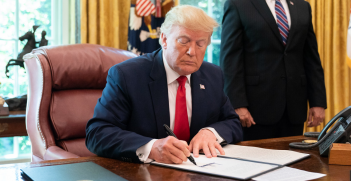Trump and Kim in Vietnam: Success Could Presage Major Power Realignment

President Donald Trump and Kim Jong Un are due to meet in Vietnam to discuss the denuclearisation of the Korean Peninsula. If successful, their efforts could lead to a major realignment of power relations in Northeast Asia.
What’s at stake?
In June 2018, President Donald Trump and Chairman Kim Jong Un held a historic first summit meeting between the United States and the Democratic People’s Republic of Korea (DPRK) in Singapore. According to the Joint Statement issued after their discussions, “President Trump committed to provide security guarantees to the DPRK, and Chairman Kim Jong Un reaffirmed his firm and unwavering commitment to complete denuclearisation of the Korean Peninsula.” The two leaders also pledged to hold follow-up negotiations at ministerial level.
In 2017, North Korea test-fired at least twenty-three ballistic missiles of varying ranges. Two missiles overflew Japan. Three of the missiles were intercontinental ballistic missiles theoretically capable of hitting the US mainland with miniaturised warheads. The DPRK conducted two nuclear tests in 2016 and another one in 2017. Its bellicose actions provoked President Trump to threaten it with “fiery and fury like the world has never seen.” Trump also derided Kim as “little rocket man.”
The first US-DPRK summit resulted in a drastic lowering of tensions on the Korean Peninsula. North Korea has ceased firing ballistic missiles and conducting nuclear tests. Further, North Korea has begun to repatriate the remains of US service personnel who went missing-in-action during the Korean War. Otherwise, little tangible progress has been made to denuclearise the Korean Peninsula. In fact, observers report that North Korea continues to produce fissile material for nuclear warheads.
In 2017, the United States demanded the complete irreversible destruction of nuclear weapons by North Korea and vowed to retain US and UN sanctions in place until this objective was achieved. In the eight months since the first summit, it is clear that the United States and North Korea hold very different views on what is meant by denuclearisation. The wording of the 2017 joint statement refers to “complete denuclearisation of the Korean Peninsula.” North Korea interprets this as including the US extended nuclear deterrence umbrella over South Korea.
The second summit will be a pivotal moment to determine whether common ground can be found to go beyond the status quo, build mutual trust and initiate the first steps in what will be a protracted process of denuclearisation. The only way forward is for both sides to agree on some form of reciprocity – or what North Korea calls corresponding measures – in which one side responds to steps by the other side.
Failure to reach a common ground holds the risk of renewed tensions and a revival of past patterns of brinkmanship.
What’s likely to be discussed?
There are so many interconnected sets of issues related to denuclearisation of the Korean Peninsula that it resembles a Gordian knot. Can Trump and Kim agree on how to untangle the separate strands?
Three sets of issues stand out. First, Trump and Kim must agree on a definition of complete denuclearisation. Trump and Secretary of State Mike Pompeo are totally focused on eliminating North Korea’s nuclear weapons complex, fissile material and the means of delivery.
The DPRK has a more expansive view. According to the official Korean Central News Agency: “When we refer to the ‘denuclearisation of the Korean Peninsula,’ it means the removal of all sources of nuclear threat not only from the North and the South but also from all neighboring areas targeting the peninsula… The denuclearisation of the Korean Peninsula should be defined as ‘completely eliminating the US nuclear threat to Korea’ before it can eliminate our nuclear deterrent.”
The second set of issues relates to the process of denuclearisation. This includes, but is not limited to, an indefinite moratorium on testing ballistic missiles and nuclear weapons, a complete inventory of North Korea’s nuclear weapons complex, the removal of fuel rods from nuclear reactors, the dismantling of all facilities related to production of nuclear weapons and their means of delivery, the destruction of ballistic missiles and nuclear warheads and removal of stockpiles of fissile materials. These steps would be observed by international inspectors.
The third set of issues includes the sequencing of reciprocal steps by the United States. These steps could include, but are not limited to, a halt to all US-Republic of Korea military exercises, exchange of liaison officers, humanitarian assistance, a partial lifting of US and/or UN sanctions, US security guarantees and a formal peace treaty ending the Korean War, normalization of diplomatic relations and developing economic relations.
What does it all mean?
President Trump has already indicated that he has no set timetable for complete denuclearisation as long as North Korea refrains from conducting any further nuclear weapons and ballistic missile tests. Trump also has indicated that the second summit with Chairman Kim is likely to be followed by other summit meetings.
If the second summit results in positive forward movement, other stakeholders such as South Korea, China, Japan and Russia will have to be brought on board; if only to take part in an international conference to ratify a putative agreement on ending the war and restoring the peace on the Korean Peninsula.
The involvement of other stakeholders will complicate US efforts to completely denuclearise North Korea. South Korea, for example, is pursuing its own policy of reconciliation with North Korea and has a direct interest in offering North Korea economic incentives. At the same time, South Korea values its alliance with the United States as a deterrent to North Korea’s nuclear and conventional forces.
China seeks stability on the Korean Peninsula and the preservation of the DPRK as a buffer. It is not in China’s interest for the DPRK to collapse or for a reunified Korea to remain a formal US ally. If and when the denuclearisation process gets underway, China will press for the removal of the Terminal High Altitude Area Defence missile system, or THAAD, from South Korea.
Japan’s interests, like South Korea, are best served by complete denuclearisation of the Korean Peninsula and retention of its alliance with the United States in order to counter China. Japan’s national security would be seriously undermined by any US withdrawal of its extended nuclear deterrence as part of a peace package with the DPRK.
Russia’s interests parallel those of China; it does not want a unified Korea dominated by the government in Seoul allied with the United States. Russia is likely to team up with China to push for a US military withdrawal from South Korea and an economic role in the DPRK as sanctions are lifted.
In sum, the process of denuclearising the Korean Peninsula could result in a major realignment of major power relations in Northeast Asia. The most positive outcome would be a concert of six powers that successfully manage the process of denuclearisation and maintains peace in Northeast Asia.
On the negative side of the ledger, the DPRK dynastic regime could collapse with China and/or Russia intervening to prevent reunification under the Seoul government allied with the United States. This would set off a new “great game” to control a reunified Korea. Finally, if the Trump Administration abandons US policy of extended nuclear deterrence in exchange for the denuclearisation of North Korea this would leave Japan exposed to face a nuclear-armed China. Ironically, complete denuclearisation of the Korean Peninsula could result in a nuclear-armed Japan.
Carlyle A Thayer is an emeritus professor at The University of New South Wales Canberra and director of Thayer Consultancy, a small business registered in Australia that provides political analysis of current regional security issues and other research support to selected clients.
This article is published under a Creative Commons License and may be republished with attribution.





